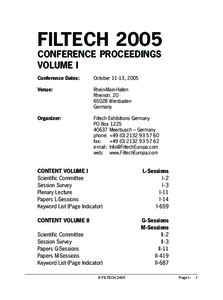Please use this identifier to cite or link to this item:
https://elib.psu.by/handle/123456789/3228Full metadata record
| DC Field | Value | Language |
|---|---|---|
| dc.contributor.author | Mota, M. | - |
| dc.contributor.author | Teixeira, J. | - |
| dc.contributor.author | Abaev, G. | - |
| dc.contributor.author | Yelshyna, I. | - |
| dc.contributor.author | Yelshin, A. | - |
| dc.date.accessioned | 2014-07-04T07:00:04Z | - |
| dc.date.available | 2014-07-04T07:00:04Z | - |
| dc.date.issued | 2005 | - |
| dc.identifier.citation | FILTECH CONFERENCE, Wiesbaden, 2005 - "FILTECH 2005 Conference Proceedings". Meerbusch : Filtech Exhibitions Germany, 2005. vol. 1, p. 341-349. | ru_RU |
| dc.identifier.other | https://repositorium.sdum.uminho.pt/handle/1822/3638 | - |
| dc.identifier.other | https://repositorium.sdum.uminho.pt/handle/1822/7736 | - |
| dc.identifier.uri | https://elib.psu.by/handle/123456789/3228 | - |
| dc.description.abstract | Centrifugation of activated sludge is a frequently used dewatering process but there is a need for a fitting function for moderate and high sludge concentrations. In particular, liquid phase accumulation kinetics during centrifugation may be used as a source of information about sedimentation properties and governing mechanism of the cake formation. This will allow the obtention of the optimal parameters for the dewatering control and process optimisation. For this purpose, activated sludge at different concentrations was investigated on a laboratory centrifuge with centrifugation factor 2667. The following sludges were used in the experiments: 1) activated sludge from thickener (with and without floculant treatment); 2) sludge after industrial centrifuge decanter Flottweg Z62-4 collected from dumping pound; sludge (2) after anaerobic treatment; sludge (2) with a dispersed solid additive. Based on the obtained data, the following assumption was made: settling of the solid phase and cake compaction depends on the hindered settling velocity and sediment compression. Due to the applied centrifuge force, a primary cake skeleton from particular aggregates and flocs is formed. During this stage, free water is displaced from the space between aggregates/flocs with a further transition to the compaction of the sediment with the water being displaced from the pores of the flocs by a filtration mechanism until an equilibrium condition is reached. The liquid volume V vs. time t at hindered settling and sediment dewatering can be represented in the form Vα tⁿ, where n ≤1.0. Therefore, in log-log coordinates, the kinetics of liquid accumulation have a linear dependence lg(V ) α n lg(t) in both settling and compaction stages. This assumption was confirmed for different types of activated sludge. Using asymptotical analysis in the function form F(t,V) , a dimensionless fitting function was obtained that describes the centrifugation of activated sludge. For highly concentrated sludge, it was found that the dewatering occurs as cake compression. Analysis of deformation models leads to the conclusion that for the compressible cake it is necessary to introduce a parameter characterising the cake plasticity dependence on the centrifugation time. Developed model was used for fitting numerous experimental data. The main advantage of proposed model is the possibility to fit the liquid phase accumulation kinetics during centrifugation in a wide range of the activated sludge concentration, from suspension up to structured and paste-like cake consistency. The extension of this model to other slurries requires further investigation. | ru_RU |
| dc.language.iso | en | ru_RU |
| dc.publisher | Filtech Exhibitions Germany | ru_RU |
| dc.subject | Физика | ru_RU |
| dc.title | Simulation of liquid phase accumulation at centrifugal dewatering of activated sludge | ru_RU |
| dc.type | Thesis | ru_RU |
| Appears in Collections: | Публикации в зарубежных изданиях | |
Files in This Item:
| File | Description | Size | Format | |
|---|---|---|---|---|
| Mota_2005.pdf | 325.02 kB | Adobe PDF |  View/Open |
Items in DSpace are protected by copyright, with all rights reserved, unless otherwise indicated.